Lorenzo Lotto Portraits in Washington National Gallery of Art
The itinerary <em>TITULORECORRIDO</em> has been successfully created. Now yous can add together in works from the Collection browser
<em>TITULOOBRA</em> added to <em>TITULORECORRIDO</em> itinerary
Lorenzo Lotto. Portraits
Museo Nacional del Prado. Madrid 6/19/2018 - 9/thirty/2018
The Museo del Prado is presenting the first major monographic exhibition on Lorenzo Lotto's portraits. Co-organised with the National Gallery in London, it is benefiting from the sole sponsorship of Fundación BBVA and is the Museum's near important exhibition this summer.
Lorenzo Lotto (Venice, 1480 – Loreto, 1557) was one of the nigh unique and fascinating artists of the Italian Cinquecento. His reputation has consistently grown among scholars and fine art lovers since Bernard Berenson devoted the first monograph to him, Lorenzo Lotto. An Essay in Constructive Criticism, published in 1895. Writing at the time of the emergence of Freudian psychoanalysis, Berenson saw Lotto as the first portraitist to be interested in reflecting his sitters' states of listen, and as such the first modern one. Although interest in the artist has been particularly notable since the 1980s, until now no exhibition has focused exclusively on the portraits, making this project a pioneering i.
The exhibition focuses on already known aspects of Lotto'southward portraiture such equally their varied typology, psychological depth and circuitous symbolism. In addition, it explores other less familiar ones such as the artist's employ of like resources in his portraits and religious works, the importance of the objects nowadays in the portraits as reflections of material culture of the 24-hour interval, and the creative process behind the realisation of these works.
Lorenzo Lotto. Portraits too offers an unprecedented perspective on the artist'southward works through the presence in the galleries of objects like to those seen in the portraits, in a reflection of cloth culture of the day. In addition, it looks at the way in which the artist conceived and executed his portraits and in this regard and given the lack of technical analyses of these works, the inclusion of drawings by him (rarely displayed aslope the paintings) are of detail importance.
The diversity of typologies that Lotto employed; the overt or concealed symbolism within them; the psychological depth with which he imbued his models; and the importance he gave to objects in order to define their status, interests and aspirations all requite these portraits a degree of profundity which permit Lotto to be seen as the artist who best reflected Italy at the fourth dimension, a land experiencing a profound period of modify.
- Curators:
- Enrico Maria Dal Pozzolo (Academy of Verona) and Miguel Falomir (Museo del Prado).
Access
Room A and B. Jerónimos Building
- Exclusive Sponsorship:
-

Multimedia
Exhibition
The exhibition
Lorenzo Lotto (Venice, ca.1480 – Loreto, 1556/57) was one of the great Renaissance portraitists due to the variety of typologies that he employed, the psychological depth with which he endowed his sitters, and his judicious use of objects to define the condition, interests and aspirations of his subjects. An artist who experienced both success and failure, after his death Lotto vicious into almost consummate oblivion until the late xixth century when the art historian Bernard Berenson (1865-1959) rediscovered him, presenting him as the showtime Italian painter interested in depicting his sitters' states of mind and hence the first modern portraitist. This estimation, which is all the same accepted today, found fertile basis in a society increasingly concerned with profound aspects of the private, and it is seemingly not past risk that Berenson was a contemporary of Sigmund Freud (1856-1939) and of the birth of psychoanalysis. This exhibition, the offset on Lotto'southward portraits, includes works created in the places where this nomadic painter was active: his native Venice, Treviso, Bergamo, Rome and the Marches, produced over the course of l years. The earliest reveal echoes of Antonello da Messina, filtered through his master Alvise Vivarini and Giovanni Bellini, in addition to northern elements (principally Dürer) and the influence of Giorgione, Raphael, Leonardo and finally Titian in the 1540s. Lotto re-elaborated these sources to codify his own language in which looks, gestures and objects combine to transcend the concrete description of the sitters and their status and thus reveal their innermost thoughts. These are paintings possessed of a powerful narrative potential which invite the viewer to imagine the lives of their subjects while as well testifying to the period of profound transformation experienced in Italia at that fourth dimension.
Early years in Treviso
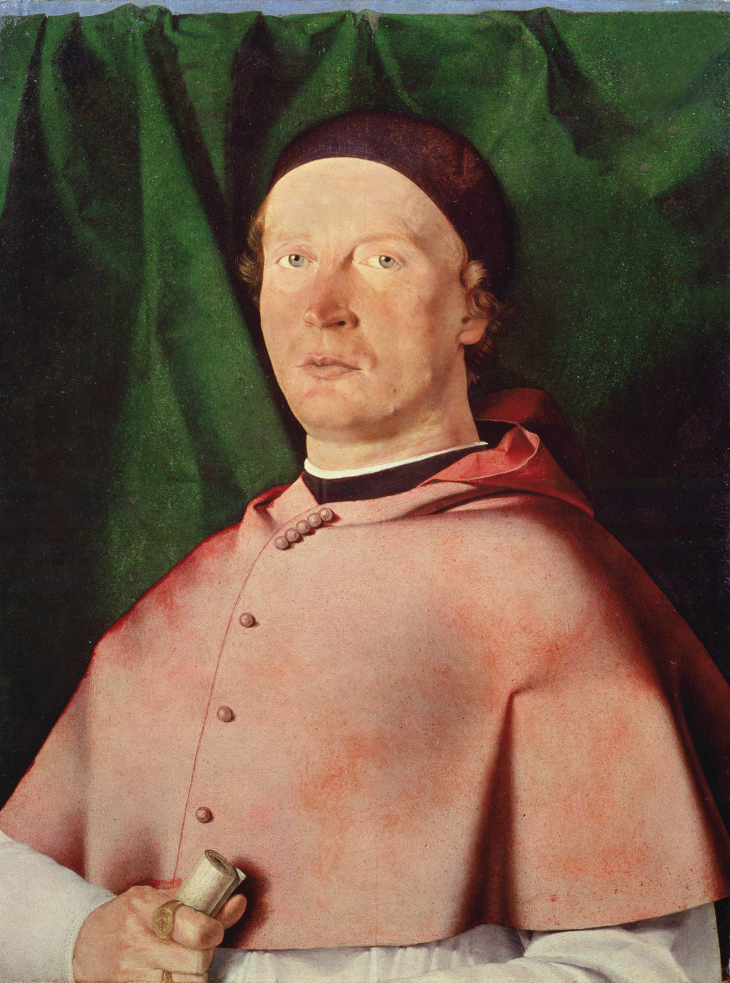
-
- Portrait of Bishop Bernardo de'Rossi
- Lorenzo Lotto
- Oil on panel, 52 x 40 cm
- 1505
- Naples, Museo Nazionale di Capodimonte
Lotto produced his outset works in Treviso, due north of Venice, effectually 1498. At this point he was an creative person dominated past the "myth" of Antonello da Messina, active in Venice between 1475 and 1476, although this influence was modified by that of other painters. The technique of his early portraits recalls Alvise Vivarini, his probable master, simply his models derive from Giovanni Bellini, the preeminent figure in Venetian painting at that appointment. In addition, Lotto's work reveals both directly northern influences (German painters were present in Treviso), and indirect ones derived from prints. This Germanic component increased following Dürer's arrival in Venice in tardily 1505. The Treviso period was a successful ane, during which Lotto established contacts with prominent intellectuals such as Bishop Bernardo de' Rossi, and his reputation spread to towns such as Asolo where he painted Caterina Cornaro, the last Queen of Republic of cyprus. He similarly flourished in Recanati in the Marches and past this point his career provided a sufficient basis to confront the slap-up challenge of Rome, where his arrival was probably facilitated by Bramante, architect to Saint Peter'due south. Lotto is documented working in the Stanza della Segnatura and di Eliodoro in 1509 although cipher survives of that project, now concealed by Raphael's frescoes.
Bérgamo, 1513-1525
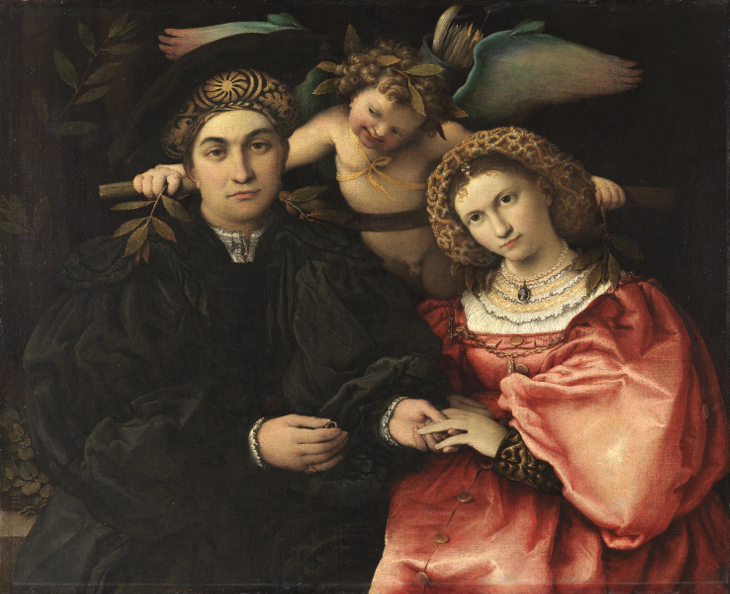
-
- Micer Marsilio Cassotti and his wife Faustina
- Lorenzo Lotto
- Oil on canvas, 71 x 84 cm
- 1523
- Madrid, Museo Nacional del Prado
Following his lack of success in Rome, in 1510-13 Lotto returned to the Marches (Recanati and Jesi) where he painted various portraits nowadays in the exhibition (Museo Thyssen-Bornemisza and the Uffizi), before moving to Bergamo in 1513. It was in that location, particularly from 1521 onwards, that he produced some of his finest portraits, commissioned by members of a wealthy and ambitious upper middle class prepared to accept innovative artistic solutions. With their encouragement Lotto experimented with every representational blazon and with an originality unparalleled in Italian art of the period. He brought significant innovations to the individual and double portrait and as well to the crypto-portrait and portraits included in devotional works. These are living images which reflect both his sitters' social condition and their cultural composure. They include numerous references to mythology, classical fine art and the civilization of emblems and all are characterised by their ability to establish a dialogue with the viewer.
The matrimonial portrait

-
- Portrait of a Married Couple
- Lorenzo Lotto
- Oil on canvas, 96 x 116 cm
- c. 1523 - 1524
- Saint Petersburg, The State Hermitage Museum
Lotto responded to the freedom conceded to him by the social elites in Bergamo with unprecedented pictorial formats. The virtually innovative was undoubtedly the matrimonial portrait, showing a couple in a single visual field accompanied past objects and elements open to a symbolic reading. It has been suggested that this typology is northern in origin and before family portraits are certainly known from Flemish region and Germany. Given Lotto'southward artistic origins, however, a classical influence should not be rejected, derived from both sculpture and from numismatics and gem carving. In these portraits, most of them associated with the prominent Cassotti family unit, Lotto employed an innovative horizontal format, the success of which subsequently led him to use it in Venice for private portraits.
Return to Venice
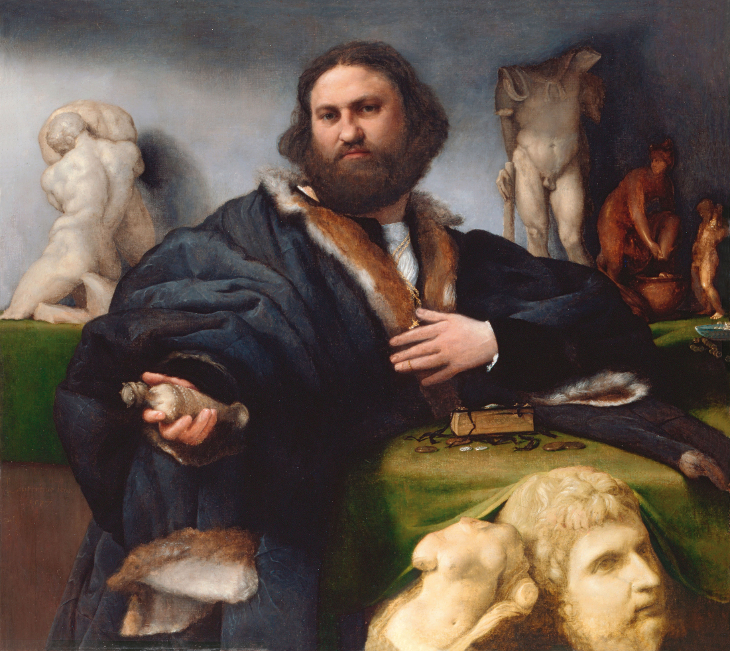
-
- Portrait of Andrea Odoni
- Lorenzo Lotto
- Oil on sail, 104.6 x 116.6 cm
- 1527
- The Imperial Collection Trust, Hampton Courtroom
Equipped with the expressive and formal resources that he devised in Bergamo, Lotto reappeared in Venice in late 1525. In the context of painting, the metropolis was more dynamic than always due to the renovatio Urbis [modernisation of the city] promoted by the authorities under Doge Andrea Gritti (1523-38). Portraiture was, notwithstanding, the pictorial genre most subject to earlier conventions, with a focus on individuals of high social rank depicted in half-length or 3-quarter format. This explains the success of the innovative proposals offered by Lotto, who adjusted the horizontal format of his betrothed portraits to private ones, introducing a "speaking" infinite into the painting through the sitters' gestures or the objects that accompany them. During these years Lotto produced some of his most memorable creations, depicting intentionally enigmatic figures in dynamic compositions of considerable size.
Lotto and the Dominicans
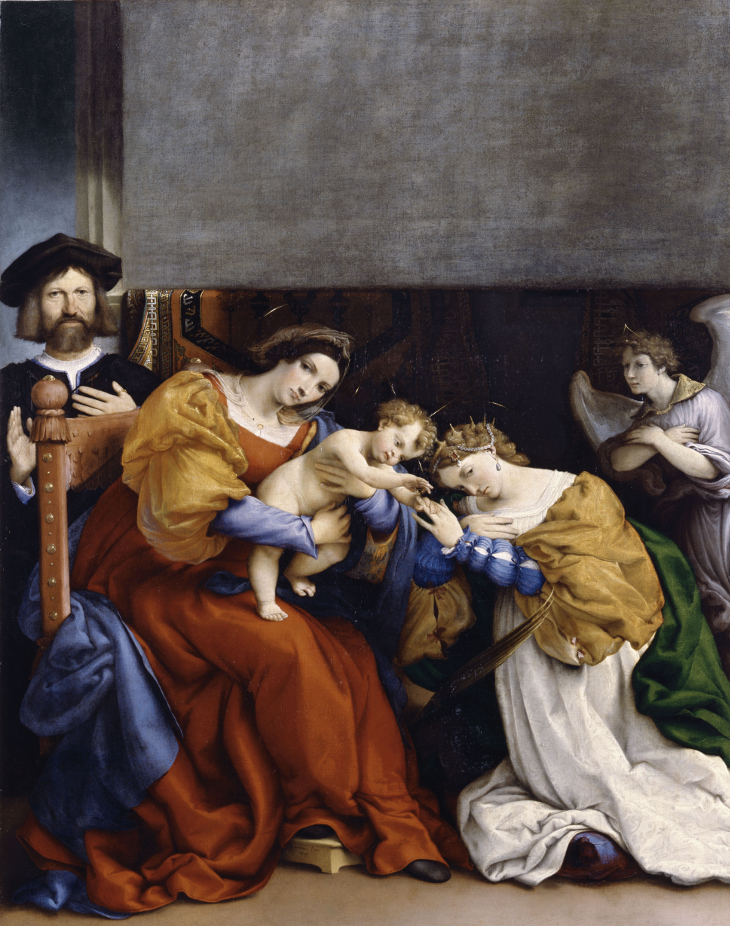
-
- Mystic Marriage of Saint Catherines with donor Nicolò Bonghi
- Lorenzo Lotto
- Oil on canvas, 172 x 143 cm
- 1523
- Bergamo, Accademia Carrara - Pinacoteca di Arte Antica
On his inflow in Venice in 1525 Lotto stayed with the Dominican community of Santi Giovanni e Paolo where he painted its treasurer, Marcantonio Luciani. Before long after this the Order may have commissioned him to execute the big pala d'altare shown in this gallery and depicting The Alms of Saint Antoninus, completed in the early on 1540s. Lotto's connections with the Dominicans, particularly its Observant co-operative, would be close and in his will of 1531 he expressed the wish to be buried in the Order'due south habit. In addition, part of the fee for the painting of Saint Antoninus came from sermons given by Friar Lorenzo da Bergamo, whose portrait is displayed later in the exhibition. Another Dominican monk, Angelo Ferretti, is represented with the attributes of Saint Peter Martyr in the last department of the exhibition. This gallery also offers a reflection on the relationship between portraiture and religious painting and on one of the liveliest debates in art at the time: the paragone, which disputed the relative merits of painting and sculpture.
Freedom in the marches
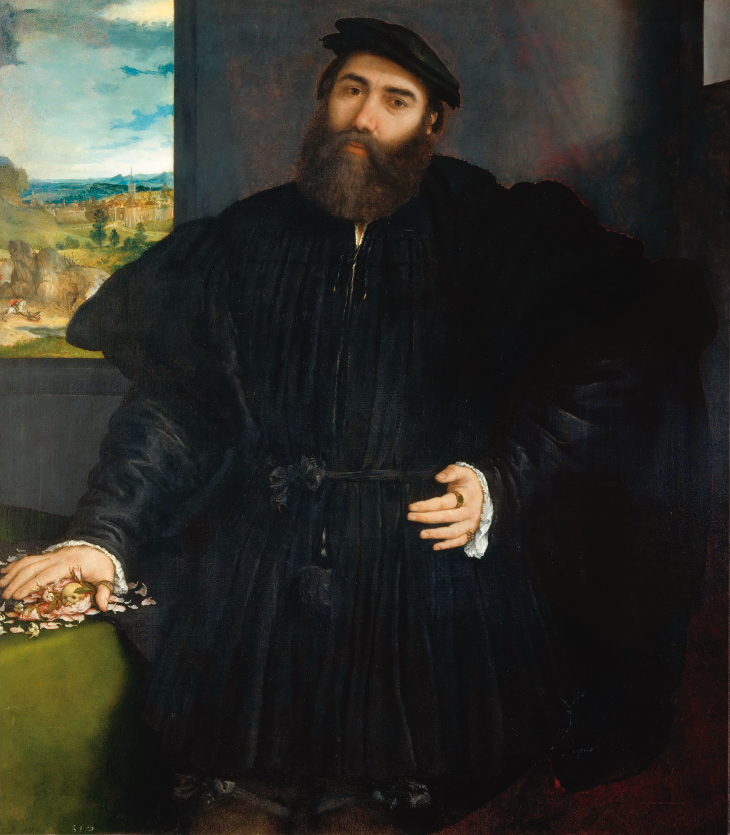
-
- Portrait of a Human
- Lorenzo Lotto
- Oil on panel, 118 x 105 cm
- c. 1535
- Rome, Galleria Borghese
Despite a few fractional successes, Lotto never achieved his desired triumph in Venice. Competition brought enemies, leading to various failures. The event was psychological distress, and in a letter of this period he admitted to being "of profoundly contradistinct mind due to various and strange disturbances." During his fourth dimension in Venice he maintained his connections with the Marches, to where he regularly sent works and where he finally moved, probably in search of a less stressful artistic surround. In 1534 he was in Ancona, in 1535 in Jesi, and then again in Ancona in 1538, followed past Macerata and Cingoli in 1539, places with a less sophisticated local clientele. For these portraits Lotto used his experience gained in Bergamo and Venice but we witness an increasing appearance of isolated, melancholy individuals, as in Portrait of a Human from the Galleria Borghese, who seem to echo his own state of listen.
"Solitary, with no trustworthy guide and very broken-hearted of mind"
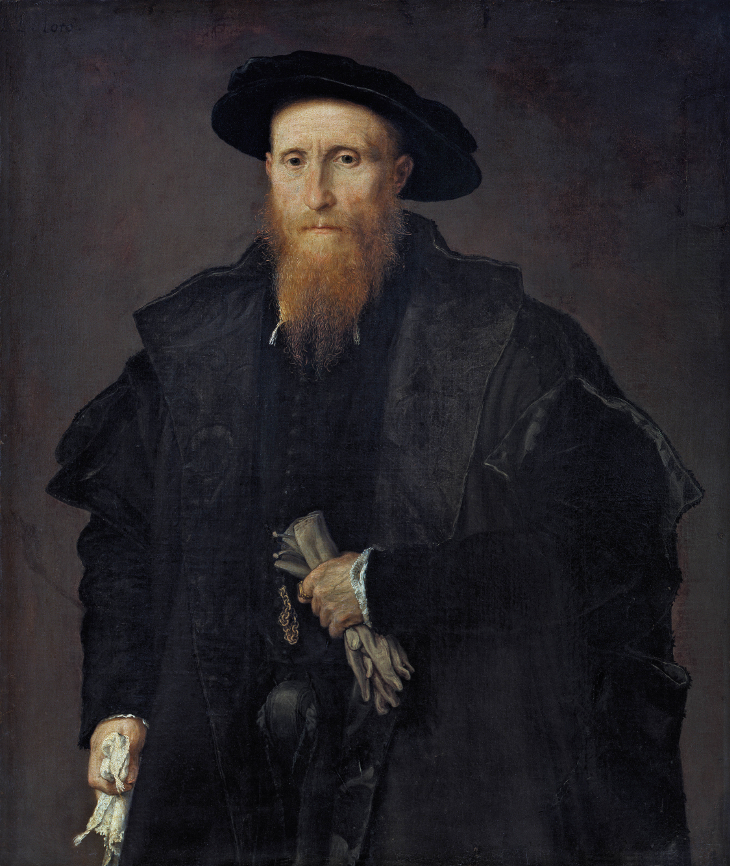
-
- Portrait of an Elderly Gentleman with Gloves (liberale da Pinedel)
- Lorenzo Lotto
- Oil on canvas, 90 10 75 cm
- 1542 - 1544
- Milan, Pinacoteca di Brera
Anile nearly sixty, in 1540 Lotto returned to Venice, merely to leave two years subsequently for Treviso. It was at that place, betwixt 1542 and 1545, that he painted some of his well-nigh intense portraits in which he represented the irreversible and devastating effects of suffering and old age, devoid of any concessions to idealisation. Most of these works are imbued with the painter'south own melancholy. A veil of sadness about similar the shadow of expiry spreads over the sitters who posed for him and paradoxically their sumptuous clothes almost learn the significance of a vanitas. These works' chromatic and compositional sobriety reflects the impact of Titian, albeit more in formal than conceptual terms as Lotto avoided idealising his models. In 1545 he returned to Venice for the terminal time, cartoon up a second volition on 25 March 1546 in which he included the phrase used every bit the title for this section of the exhibition: "Alone, with no trustworthy guide and very anxious of mind."
Drawings
Drawings by Lotto, whether portraits or religious compositions, take been almost entirely absent-minded from exhibitions on the creative person, which has complicated their report. The present one includes diverse examples of unlike types attributed to the artist. Some must take been made equally preparatory studies for painted portraits, ranging from chop-chop-executed sketches to squared-up designs to be transferred to console or canvas. Others are and so highly finished that they seem independent works, possibly made every bit gifts. From the Libro di spese diverse, in which Lotto gear up out his accounts, we know the multifariousness of drawing materials that he caused (charcoal, black and white chalk, tailor'south chalk and ink), revealing his versatility equally a draughtsman. Also on display is a fascinating portrait in oil on paper recently attributed to the creative person, which has the spontaneity of a sketch from life and represents an example of this technique, recorded in documents but known from very few surviving examples.
Late protraits
In 1549 Lotto left his native Venice for the final time and returned to the Marches. Past at present physically weak, weary and disillusioned, he was so in need of money that he organised a lottery in Ancona to sell his works but with disappointing results. It was hither that he painted his last portraits, characterised past an intensity and inventiveness no longer present in his large religious compositions of this period. Lotto spent his last years in the sanctuary at Loreto, which he entered in the summertime of 1552. He became a lay member in 1554 and was buried at that place in tardily 1556. Significantly, he painted various works for the sanctuary but none of them were portraits. He left his few possessions there, including his account volume, the Libro di spese diverse, a unique document which allows for a detailed reconstruction of the last two decades of his life and identifies the individuals whom he portrayed.
Crypto-portraits
Crypto-portraits were a speciality of Lotto's which he cultivated throughout his career, comprising depictions of the sitter with the attributes of the figure with whom they identified; a classical deity such as Venus, an aboriginal heroine or a saint of their special devotion. Particularly numerous are Lotto'due south portraits of Dominicans monks with the symbols of saints of their Gild and this exhibition includes examples of friars portrayed as Saint Thomas Aquinas or Saint Peter Martyr. Information technology is very likely they were commissioned past these monks' communities every bit "mirrors of virtue" for their members but in many cases the degree of identification achieved past Lotto between sitter and saint is troublingly ambiguous.
Artworks
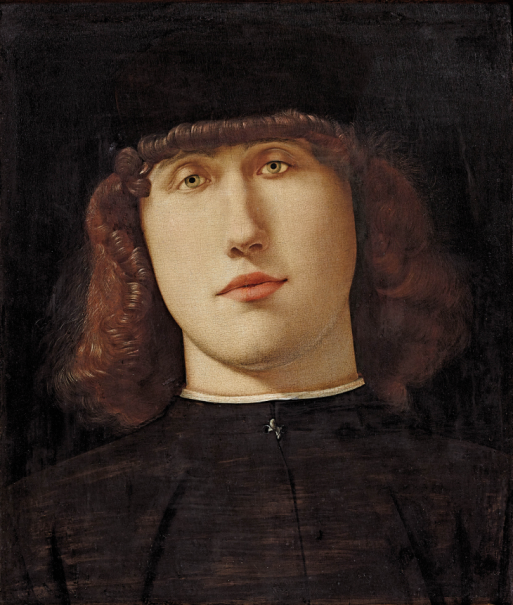
one
Portrait of a Swain
Lorenzo Lotto
Oil on panel, 34.2 ten 27.9 cm
c. 1498 - 1500
Bergamo, Accademia Carrara - Pinacoteca di Arte Antica
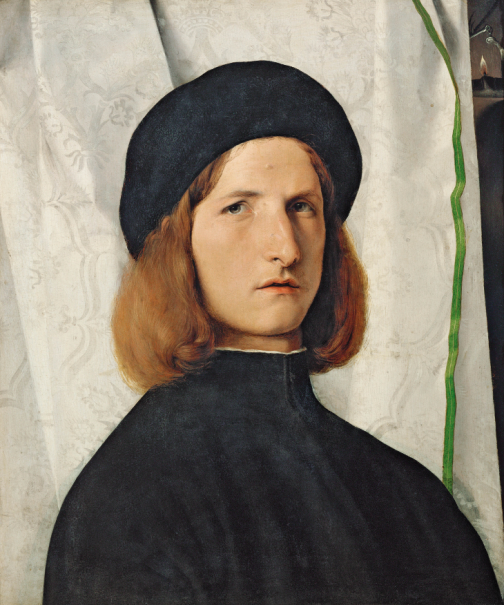
three
Portrait of a Young Man with a Lamp
Lorenzo Lotto
Oil on panel, 42.iii x 35.3 cm
c. 1506
Vienna, Kunsthistorisches Museum, Gemäldegalerie
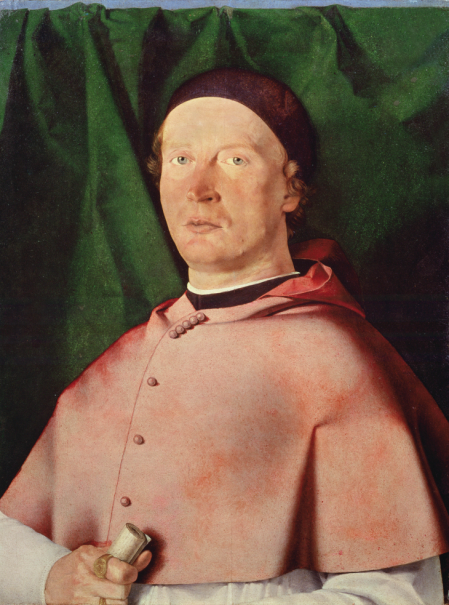
iv
Portrait of Bishop Bernardo de' Rossi
Lorenzo Lotto
Oil on panel, 52 x twoscore cm
1505
Naples, Museo east Real Bosco di Capodimonte
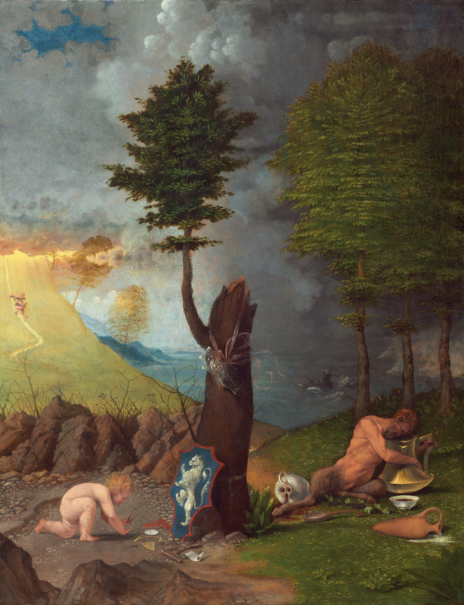
5
Allegory of Virtue and Vice
Lorenzo Lotto
Oil on panel, 56.5 x 47.2 cm
1505
Washington, National Gallery of Art, Samuel H. Kress Collection, 1939.1.156
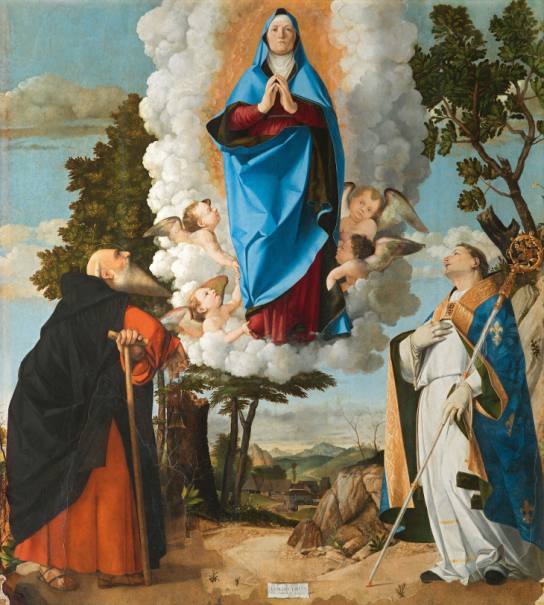
6
Assumption of the Virgin with Saints Anthony Abbot and Louis of Toulouse
Lorenzo Lotto
Oil on panel, 175 10 165 cm
1506
Asolo, catedral de Santa Maria Assunta
7
Portrait of a Man
Lorenzo Lotto
Oil on panel, 29 x 23 cm
c. 1512 - 1513
Florence, Galleria degli Uffizi
viii
Portrait of a Human being
Lorenzo Lotto
Oil on panel, 43 x 35 cm
1510 - 1513
Madrid, Museo Thyssen Bornemisza
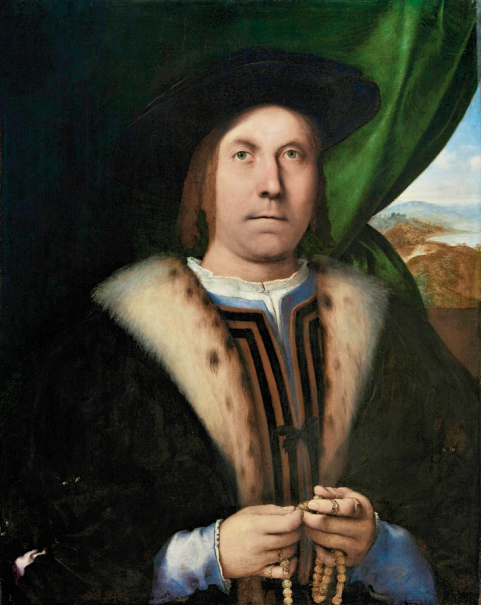
9
Portrait of a Man with a Rosary
Lorenzo Lotto
Oil on console, 78.5 x 62 cm
c. 1518
Nivå, The Nivaagaard Collection
10
Rosary
Bister
c. 1600
Florence, Galleria degli Uffizi, Tesoro dei Granduchi, Museo degli Argenti
eleven
Ornamental Band
Gilded
16 Century
Oxford, Ashmolean Museum, University of Oxford. Presented by c.D.E. Fortnum in honour of Queen Victoria's Diamond Jubilee, 1897
12
Giovanni Agostino Della Torre with His Son Nicolò
Lorenzo Lotto
Oil on canvas, 85 x 68.2 cm
c. 1515 – 1516
London, The National Gallery
thirteen
Lucina Brembati
Lorenzo Lotto
Oil on console, 52.6 x 44.eight cm
1520 - 1523
Bergamo, Accademia Carrara - Pinacoteca di Arte Antica
14
Cartoon of a Weasels'south fur
Hans Mielich
Opaque pigments on parchemin
c. 1551 - 1555
Munich, Bayerisches Nationalmuseum
15
Christ taking Leave of his Female parent, with Elisabetta Rota
Lorenzo Lotto
Oil on sail, 126 10 99 cm
1521
Berlin, Staatlische Museen, Preussischer Kulturbesitz, Gemäldegalerie
16
Virgin with the Child and Six Saints
Lorenzo Lotto
Oil on sail, 98 10 115 cm
1524
Rome, Galleria Nazionale d'Arte Antica di Palazzo Barberini
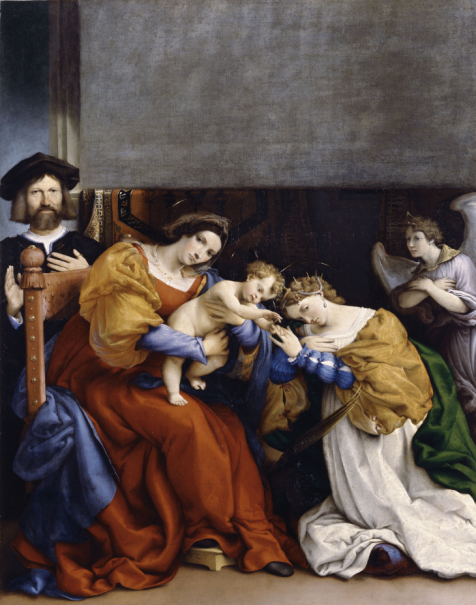
17
Mystic Marriage of Saint Catherines with donor Nicolò Bonghi
Lorenzo Lotto
Oil on canvas, 172 x 143 cm
1523
Bergamo, Accademia Carrara - Pinacoteca di Arte Antica
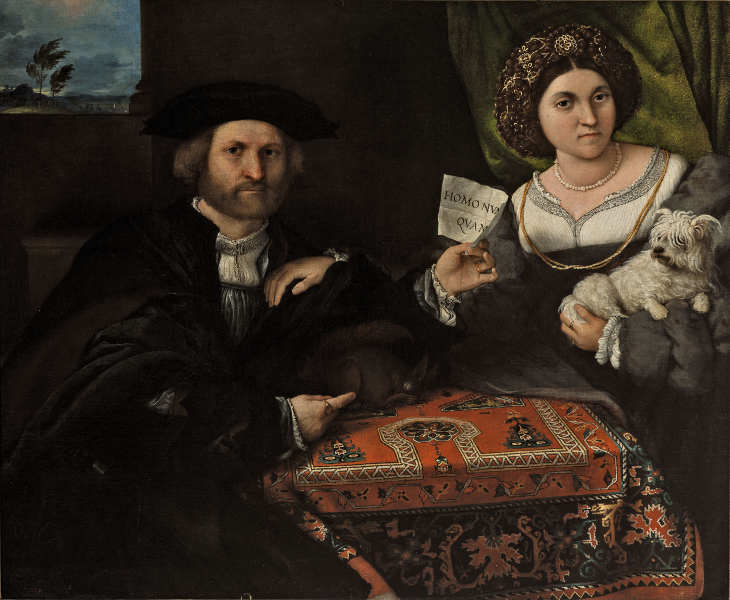
eighteen
Portrait of a Married Couple
Lorenzo Lotto
Oil on sheet, 96 x 116 cm
c. 1523 - 1524
Saint Petersburg, The State Hermitage Museum
19
Study for a Double Portrait
Lorenzo Lotto
Pen and dark grey ink, squared in red chalk, 169 10 217 cm
c. 1524 - 1525
Amsterdam, Rijksmuseum
xx
Men'south shirt
Taffeta, lace and linen
1650 - 1700
Prato, Museo Tessuto
22
Querinian Dypthic
Ivory, xiv 10 25 cm
5th century Advertizement
Brescia, Fondazione Brescia Musei. Santa Giulia
23
Cameo Faustina la Mayor
Agate and gold
Xvi Century
Florence, Galleria degli Uffizi, Tesoro dei Granduchi, Museo degli Argenti
24
Áureos de Antonino Pío a nombre de Faustina hija
Gold, 2 cm diameter
Rome, 141-161 B.C.
Madrid, Museo Arqueológico Nacional
25
Portrait of a Young man with a Book
Lorenzo Lotto
Oil on panel, 34.5 x 27.five cm
c. 1526
Milano, Pinacoteca del Castello Sforzesco
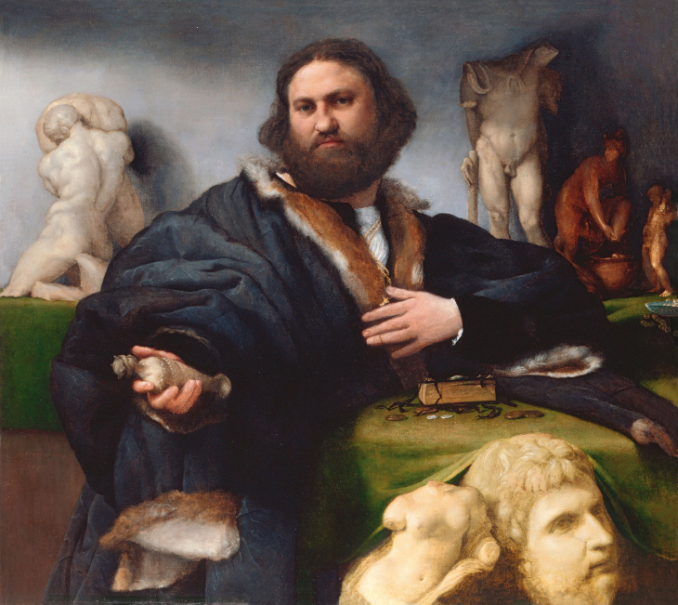
26
Andrea Odoni
Lorenzo Lotto
Oil on canvas, 104.6 x 116.6 cm
1527
London, Hampton Court, The Royal Collection, Lent by Her Majesty the Queen
27
Hércules and Antaeus
Lorenzo Lotto
Cartoon
1508 - 1510
Milano, Veneranda Biblioteca Ambrosiana
28
Standing figure reclined in a cavalcade
White marble, 56 cm h.
Padova, Università degli Studi i Padova. Museo di Scienze Archeologiche due east d'Arte
29
Ephesian Artemis
Marble, 36.8 cm h.
Roman, c.100-125 A.D., and 18th century
Cologne, Private Collection
30
Bosom of Adriano Grimani
Marble
Venice, Museo Archeologico Nazionale
31
Hercules
Bronze 90 mm h
Madrid, Museo Lázaro Galdiano
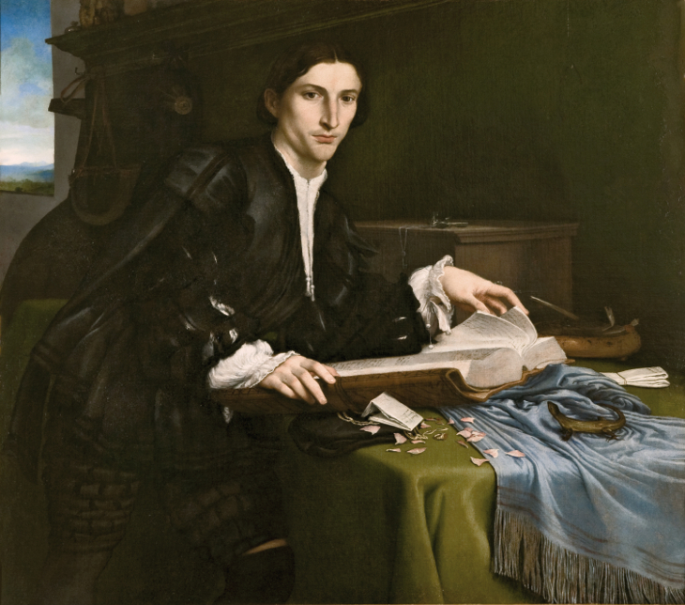
32
Portrait of a Young Man
Lorenzo Lotto
Oil on sail, 98 10 111 cm
1530 - 1532
Venice, Gallerie dell'Accademia
33
An Ecclesiastic in his Study
Lorenzo Lotto
Drawing, 162 x 198 mm
London, The British Museum, Donated by Count Antoine Seilern,1951
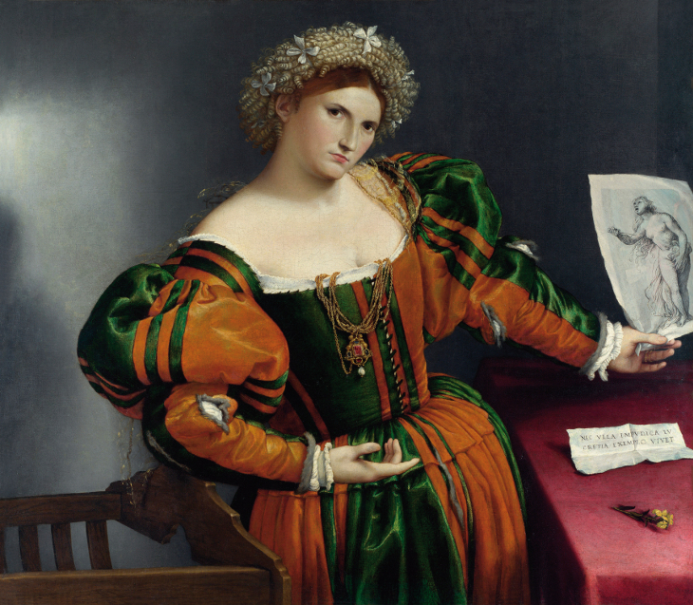
34
Portrait of a Lady as Lucretia
Lorenzo Lotto
Oil on canvas, 96.5 x 110.half dozen cm
c. 1530 - 1533
London, The National Gallery
35
Suicide of Lucrecia
Marcantonio Raimondi after Rafael
Burin, 212 10 130 mm
c. 1509 - 1514
Amsterdam, Rijksmuseum
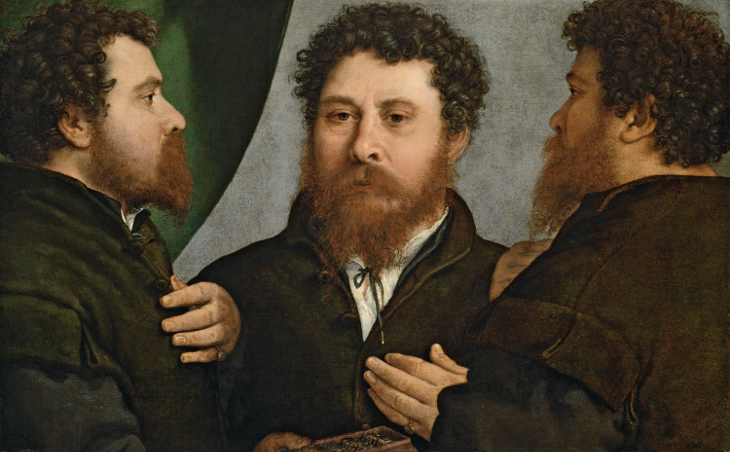
36
Triple Portrait of a Goldsmith
Lorenzo Lotto
Oil on sheet, 52 x 79 cm
c. 1530
Vienna, Kunsthistorisches Museum, Gemäldegalerie
37
Portrait of a Bearded Human being
Lorenzo Lotto
Drawing, 237 x 178 mm
c. 1530
Edimburgh, National Galleries of Scotland
38
The Alms-Giving of St. Anthony
Lorenzo Lotto
Oil on canvas, 332 x 225 cm
1540 - 1542
Venice, Chiesa dei santi Giovanni e Paolo
39
Anatolian style "Lotto" carpet
Occidental Anatolia
Wool, 177 x 108 cm
c. 1500
Milano, Zaleski Collection, Courtesy of Moshe Tabibnia Gallery
40
Crist Carrying the Cross
Lorenzo Lotto
Oil on sail, 66 x lx cm
1526
Paris, Musée du Louvre, Département des Peintures, Acquis en 1892
41
Bishop Tomasso Negri
Lorenzo Lotto
Oil on panel, 42 10 53.eight cm
1527
Split, Convento franciscano de San Antonio en Poljud / Franjevacki samostan sv. Ante na Poljudu
42
Portrait of a Dominican Friar (Marcantonio Luciani?)
Lorenzo Lotto
Oil on canvass, 78 10 67 cm
1526
Treviso, Musei Civici
43
Portrait of a Gentleman
Lorenzo Lotto
Oil on canvas, 108.two x 100.5 cm
1535?
Cleveland, The Cleveland Museum of Art, Gift of the Hanna Fund
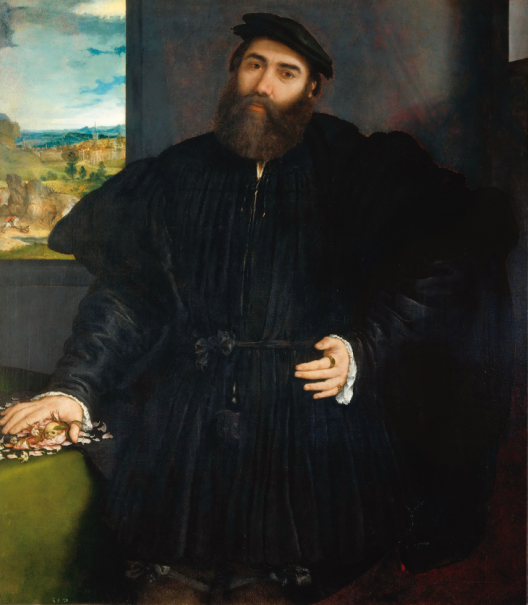
44
Portrait of a Man
Lorenzo Lotto
Oil on panel, 118 x 105 cm
c. 1535
Rome, Galleria Borghese
45
Portrait of a Gentleman
Lorenzo Lotto
Oil on canvas, 97 10 85 cm
c. 1540
New Orleans Museum of Art, The Samuel Kress Drove 61.79
46
Portrait of a Man with a Felt Chapeau
Lorenzo Lotto
Oil on newspaper, 57.viii 10 46.five cm
c. 1541
Ottawa, National Gallery of Canada
47
Portrait of an Architect
Lorenzo Lotto
Oil on canvass, 105 x 82 cm
c. 1540 - 1542
Berlin, Staatliche Museen zu Berlin, Gemäldegalerie
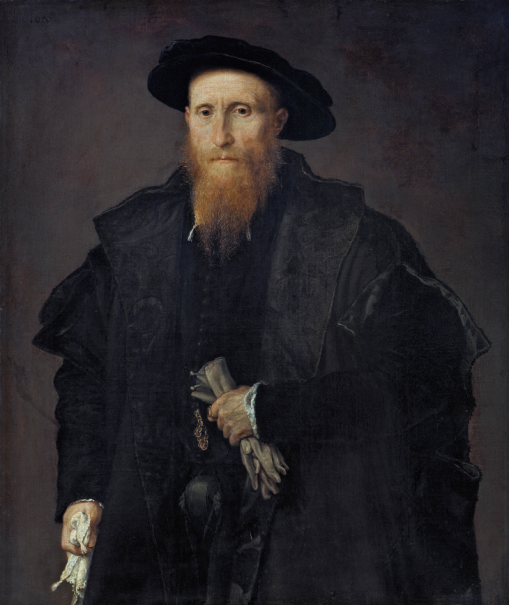
48
Portrait of an Elderly Gentleman with Gloves (liberale da Pinedel)
Lorenzo Lotto
Oil on canvass, 90 x 75 cm
1542 - 1544
Milano, Pinacoteca di Brera
49
Portrait of the Surgeon Gian Giacomo Bonamigo with His Son Giovanni Antonio
Lorenzo Lotto
Oil on canvas, 89.2 10 74.half dozen cm
1544
Philadelphia, Philadelphia Museum of Art, John G. Johnson Drove, 1917
fifty
Friar Lorenzo of Bérgamo
Lorenzo Lotto
Oil on sheet, 83.1 x 69.6 cm
1542
Baltimore, The Walters Art Museum
51
Portrait of a Human being (Lorenzo Lotto?)
Attributed to Lorenzo Lotto
Oil on paper, 189 x 187 mm
c. 1540
Berlin, Staatliche Museen, Preussischer Kulturbesitz, Gemäldegalerie, Kupferstichkabinett
52
Portrait of a Man
Attributed to Lorenzo Lotto
Drawing, 404 x 306 mm
c. 1530
Vienna, The Albertina Museum
53
Head of a Man wearing a Cap
Lorenzo Lotto
Paper, fatigued, blackness chalk and grey launder (much retouched) 269 10 194 mm
c. 1504 - 1506
London, The British Museum. Exchange with Colnaghi, 1902
54
Portrait of Young man
Attributed to Lorenzo Lotto
Drawing
c. 1520
Florence, Galleria degli Uffizi, Gabineto dei Disegni
55
Portrait of a Disguised Homo
Lorenzo Lotto
Newspaper, 250 x 186 mm
c. 1540
Florence, Galleria degli Uffizi, Gabinetto dei Disegni
56
Friar Gregorio Belo di Vicenza
Lorenzo Lotto
Oil on canvas, 87.3 ten 71.ane cm
1547
NewYork, The Metropolitan Museum of Fine art, Rogers Fund, 65.117
57
Gregorio I. Omelie di santo Gregoria Papa sopra li Evangeli: nuovamente stampate, historiate & in lingua Tosca ridotte, & con somma diligentia corrette
Francesco Bidoni y Mapheo Passini
Venice, 1543
Venice, Biblioteca Nazionale Marciana
58
Ludovico Grazioli
Lorenzo Lotto
Oil on canvas, 84.5 x 71 cm
c. 1551
Ferrara, Fondazione Cavallini Sgarbi
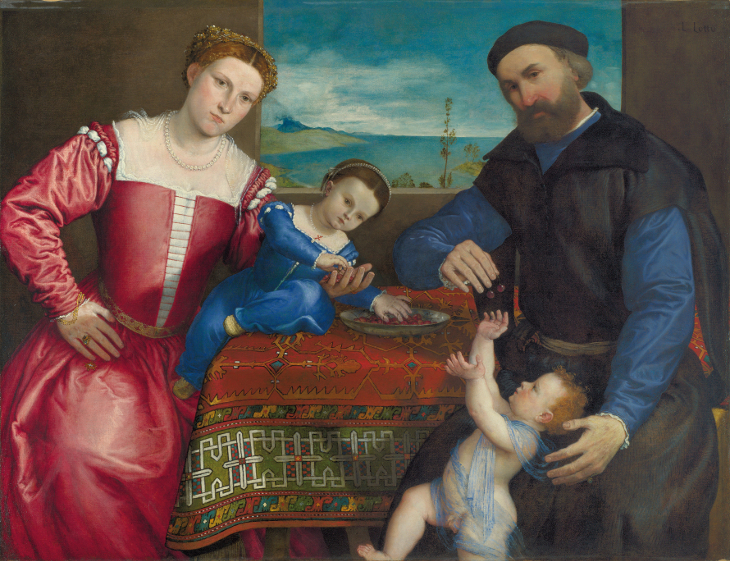
59
Portrait of Giovanni della Volta with his Wife and Children
Lorenzo Lotto
Oil on canvas, 104.5 x 138 cm
1547
London, National Gallery, Bequeathed past Miss Sarah Solly, 1879
sixty
Female Dress (called "of the grand Duchess")
Cutting cherry-red velvet and red silk with blood-red silk and gilt thread
Florence, c. 16th century
Pisa, Museo di Palazzo Reale
61
Friar Angelo Ferretti as Saint Peter Marty
Lorenzo Lotto
Oil on canvas, 89.ix 10 69.iv cm
1549
Cambridge, Harvard Art Museums/Fogg Museum, 1964.iv
62
Tractatus de gratiis expectatiuis ac aliis litteris gratie at iustitie olim bo
Giovanni Stafileo
Venice, 1540
Barcelona, Biblioteca Nacional de Catalunya
63
Portrait of an Archman (Maestro Battista di Rocca Contrada)
Lorenzo Lotto
Oil on canvas, 92 x 74 cm
1551 - 1552
Rome, Musei Capitolini, Pinacoteca Capitolina
64
Crossbow
Forest and steel, 12 x 51.1 x 79.five cm
End of 16th century
Madrid, Colecciones Reales, Patrimonio Nacional, Existent Armería
65
Lorenzo Lotto's Volition
Venice, 25 de March 1531, with a codicile 15 January 1533
Venice, Archivio di Stato di Venezia
Catalogue
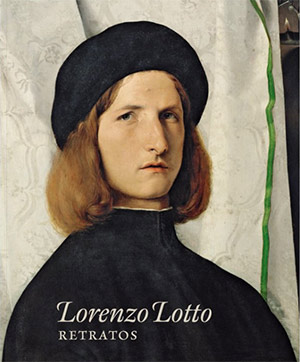
The catalogue that accompanies this exhibition, the first to be devoted to Lotto'south portraits, follows the footsteps of this nomadic painters from his native Venice to Treviso, Bergamo, Rome and the Marches through the portraits which he painted over the form of fifty years. These works reveal a range of influences from Antonello da Messina to Titian, in addition to his master Alvise Vivarini, Giovanni Bellini, Albrecht Dürer, Giorgione, Raphael and Leonardo. Lotto reinterpreted these sources in order to formulate his own visual language in which looks, gestures and objects combine to transcend the sitters' concrete advent and social condition and reveal their innermost thoughts. These are works of enormous narrative potential which invite the viewer to imagine the lives of the subjects while reflecting on the nature of Italian republic at the time, a country in a profound land of transformation.
Edited by Miguel Falomir and Enrico Maria Dal Pozzolo and with the collaboration of Matthias Wivel, the catalogue includes texts past leading specialists which focus on technical, material, social and iconological problems relating to Lotto's portraits in addition to a revision of the documentary sources essential for their study.
- Title
- Lorenzo Lotto. Portraits
- Measures
- 24 x 30 cm
- Bounden
- Paperback
- Language
- Spanish and English language
- ISBN
- 978-84-8480-371-3
- Year
- 2018
- Artist
- Miguel Falomir, Enrico Maria Dal Pozzolo, Matthias Wivel
- NIPO
- 037-eighteen-025-0
Activities
Prado Shop
Impress on demand
Print artworks available in our catalogue in high quality and your preferred size and finish.
Prototype archive
Asking artworks bachelor in our catalogue in digital format.
Source: https://www.museodelprado.es/en/whats-on/exhibition/lorenzo-lotto-portraits/4efebe6a-ba81-ab76-08b9-83363fb32538
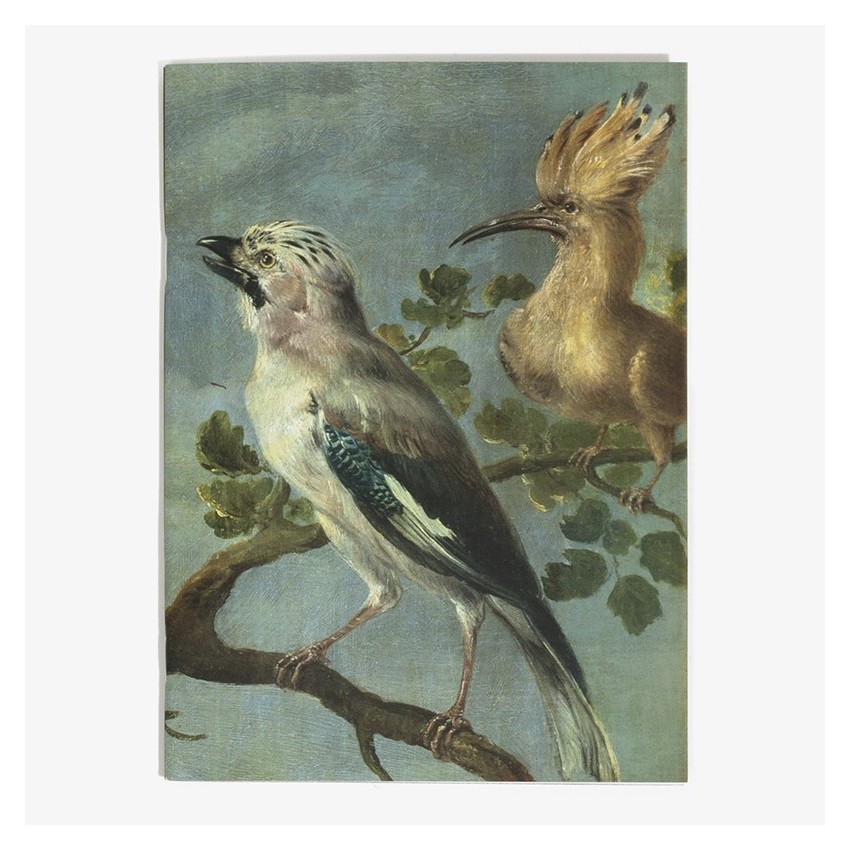


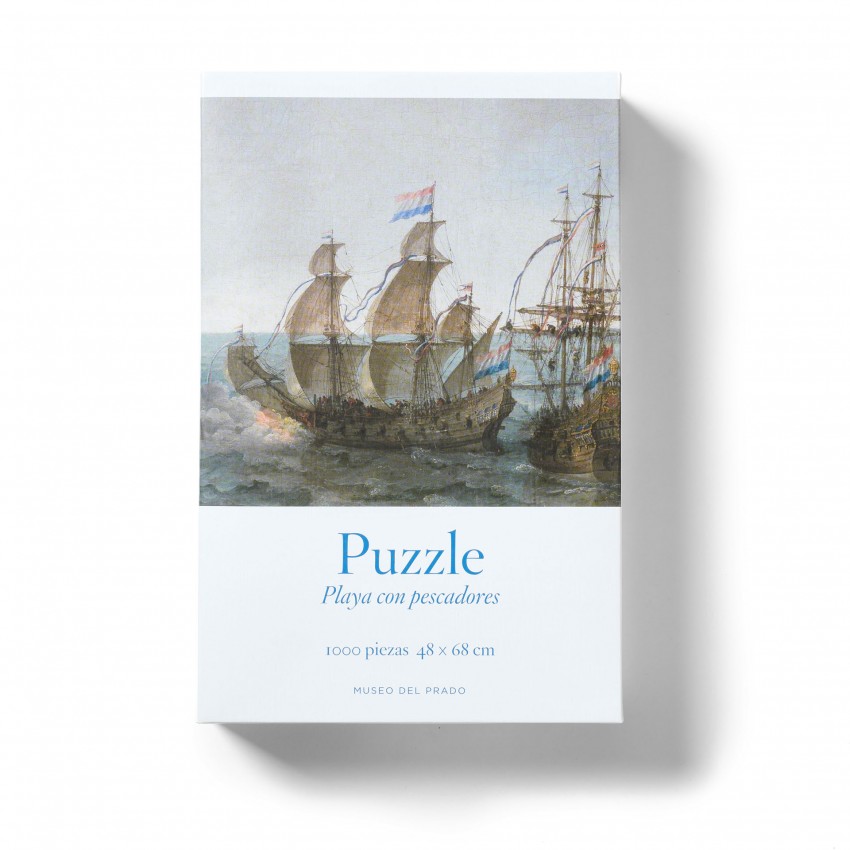


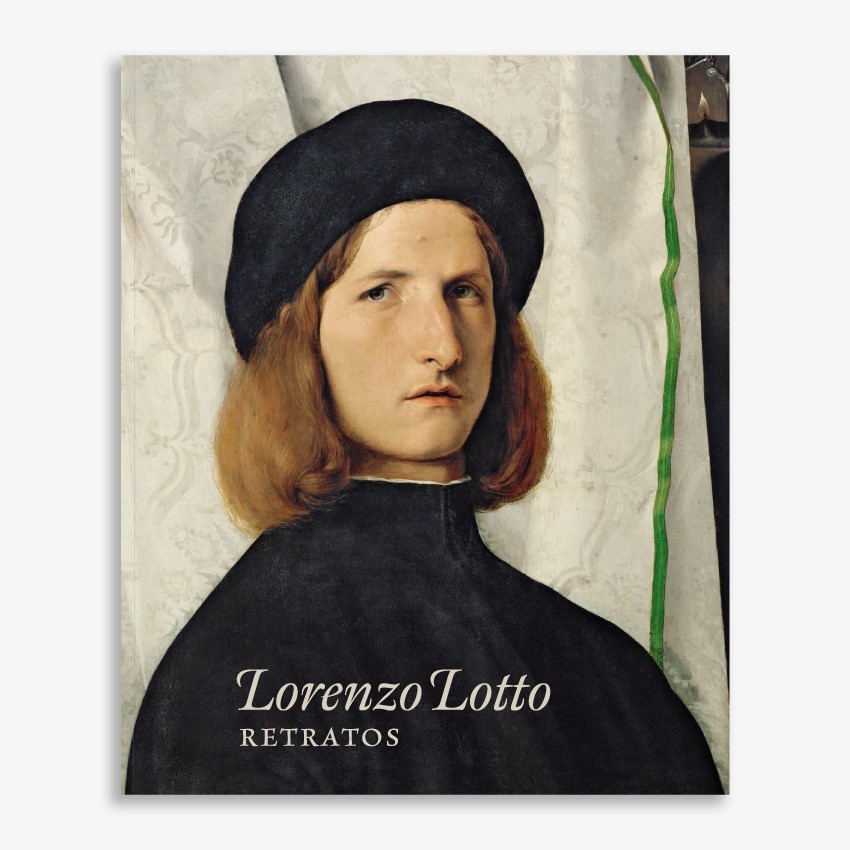

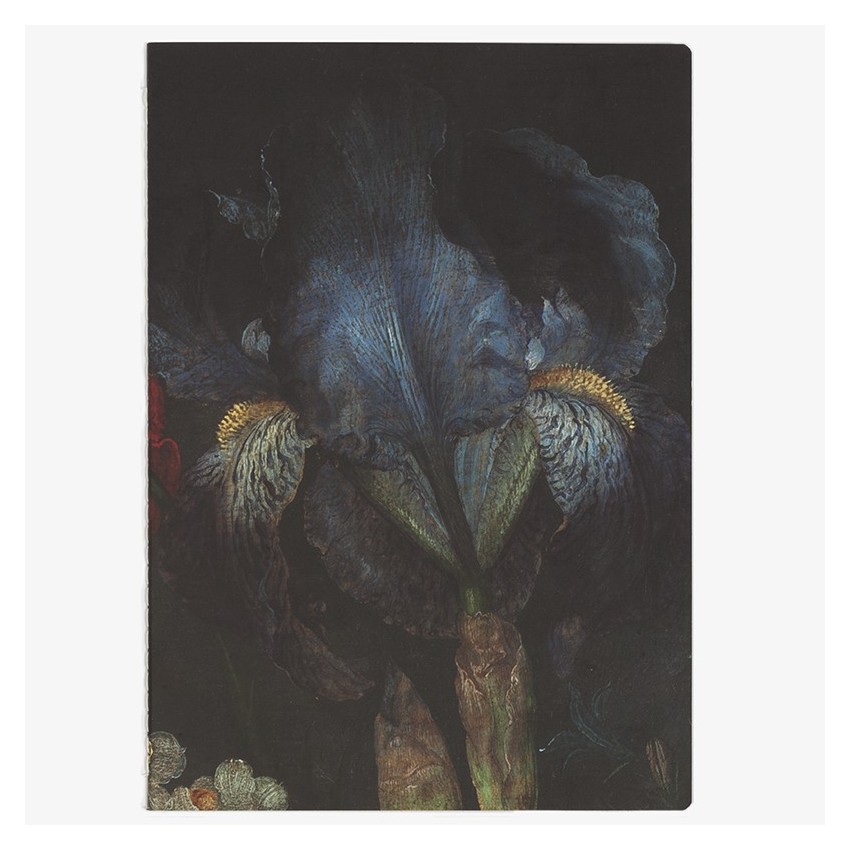

0 Response to "Lorenzo Lotto Portraits in Washington National Gallery of Art"
Post a Comment